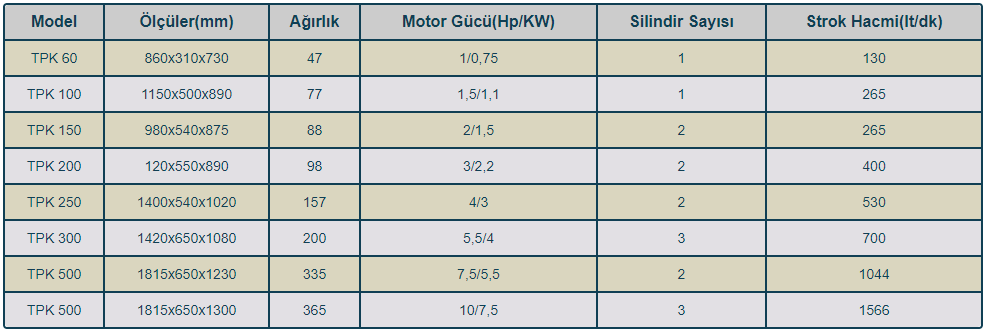Piston Compressor
- Home
- Compressors
- Piston Compressor
Piston Compressor

Piston compressors, like other types of compressors, are used to obtain compressed air, though their working principle is unique. Simply put, air is drawn into a chamber where a piston moves up and down, compressing the air and generating compressed air. Let’s delve deeper into the working principle of piston compressors.
The intake process begins as air or gas is drawn in by the piston’s movement, passing through filters that remove harmful particles. The cleaned air then moves to the intake valves. During the piston’s reciprocating motion, the air is compressed and transferred through discharge valves. Piston compressors are classified based on the pressure they produce: single-stage compressors for low pressure and two-stage compressors for high pressure.
Single-Stage Compressors:
In single-stage compressors, the compressed air is collected through a collector, then passed through a check valve into an air tank. The check valve prevents the compressed air from returning to the compressor.
Two or Three-Stage Compressors:
These are used to achieve higher pressures. The low-pressure air from the first stage is transferred to subsequent stages and then to a cooling system. After passing through the check valve, the compressed air is stored in an air tank. Water molecules condense and are expelled via discharge valves, leaving moisture-free compressed air ready for use. If further moisture removal is required, an air dryer system can be added.
Piston compressors effectively demonstrate thermodynamic principles but have many components that may wear over time. The internal structure comprises many interconnected cylinders, and wear on parts like rings can cause oil leaks. Cooling methods vary by size: large compressors are water-cooled, while smaller ones are air-cooled.
Types of Piston Compressors:
Open Type Compressors:
Open type compressors feature a flexible structure where any desired type of engine can be used. They operate efficiently across a range of temperatures and are suitable for environments with a single power source and 40 hertz frequency.Hermetic Compressors:
Hermetic compressors do not have a shaft extending to the crankcase, eliminating the need for a sealing part. They are less flexible than open type compressors but are designed for specific applications.
Working Principle:
Piston compressors can compress various technical gases up to 2000 bar pressure. They are categorized by cylinder configuration (single or multi-cylinder) and stage (single or multi-stage). Multi-stage compressors are used for high pressure, while multi-cylinder compressors are preferred for high capacity.
Air is stored and compressed by the piston’s back and forth motion. Increased pressure opens the outlet valve, releasing the compressed air. In single-acting compressors, air is drawn in and expelled from the same direction, while double-acting compressors draw in air from one side and expel it from the other.
Piston Compressor Types:
- Belt Pulley Piston Compressors
- Coupled Piston Compressors
- High Pressure Piston Compressors
Electrically operated piston compressors are common in industrial settings, while diesel or gasoline-powered compressors are used in mobile applications like construction.
Key Components:
- Crankshaft
- Piston Rod
- Body and Cylinder
- Intake and Exhaust Valves
Single-stage compressors handle pressures up to 56 bar. For higher pressures, multi-stage compressors are used. The cooling stage between low and high-pressure stages helps manage heat generated during compression, essential for maintaining lubrication and performance.
Designs vary widely, with additional cooling stages often included. Large compressors typically feature water cooling, while smaller ones use air cooling. Effective lubrication is crucial to prevent wear and ensure efficiency.
High-pressure compressors are widely used in applications requiring small amounts of compressed air, such as iron casting and steam-powered machines. These compressors are vital in industrial settings, providing reliable high-pressure air supply.
Price Factors:
The price of piston compressors depends on quality, internal components, and brand. Investing in a high-quality compressor ensures durability and optimal performance.


